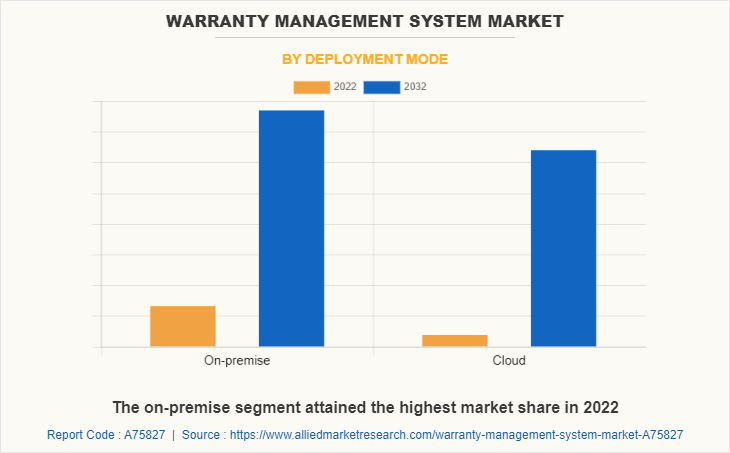Warranty Management System Market Insights, 2032
The global warranty management system market was valued at $3.7 billion in 2022, and is projected to reach $16.1 billion by 2032, growing at a CAGR of 16.2% from 2023 to 2032.
A warranty management system is a software application used by businesses to manage their product warranties. It helps track warranty claims, manage repair processes, and provide support to customers who have purchased products with warranties. This system helps businesses to keep track of their warranties and ensure that they provide the necessary support to their customers in case of any issues with their products. Moreover, warranty management system auto-generates claims, integrates information into the claim templates through mobile feeds and diagnostic devices. Moreover, it also supports return material authorization or RMA, live tracking, authorization of return, registration of stock, and more. Thus, this application serves exceptionally in enhancing the product’s quality, maintaining claims, improving customer satisfaction, and processing claims.

Furthermore, with increasing competition in the global market, manufacturers are striving to differentiate their products by offering better after-sales services. This includes providing extended warranty periods, faster claims processing, and better customer support. As a result, manufacturers are heavily investing in warranty management systems to streamline their after-sales service operations and improve customer satisfaction, which leads to the growth of the market. Moreover, surge in adoption of cloud-based solutions has a significant impact on the warranty management system market. With more companies opting for cloud-based solutions, there has been an increase in the demand for warranty management systems that can be accessed and managed from anywhere, anytime, and through any device with internet connection. This has led to increase in adoption of cloud-based warranty management solutions, thereby driving the growth of the warranty management system market.
However, resistance to change limits the adoption of new technologies, which affects the growth of the market. In addition, lack of awareness for the warranty management system due to lack of marketing and promotion of these systems acts as the key deterrent factor of the global market. On the contrary, as companies continue to invest in the development of new products, the need for an efficient and effective warranty management system becomes increasingly important. Thus, the emergence of new technologies is expected to present lucrative opportunities for the expansion of the global warranty management system market in the upcoming years.
The report focuses on growth prospects, restraints, and trends of the warranty management system market analysis. The study provides Porter’s five forces analysis to understand the impact of various factors, such as bargaining power of suppliers, competitive intensity of competitors, threat of new entrants, threat of substitutes, and bargaining power of buyers, on the warranty management system market.
Segment Review
The warranty management system market is segmented on the basis of component, deployment mode, industry vertical, and region. Based on component, it is segmented into software and service. By deployment mode, it is segmented into on-premise and cloud. By industry vertical, it is segmented into manufacturing, automotive, healthcare, supply chain & logistics, food & beverages, and others. By region, it is analyzed across North America, Europe, Asia-Pacific, and LAMEA.

Based on deployment mode, the on-premise segment attained the highest growth in 2022. This is because on-premise solutions give companies more customization options and the ability to integrate with other systems already in place. This is particularly important for companies with legacy systems that need to be integrated with newer solutions. Thus, these factors, along with others, are contributing to the growth of the warranty management system in the on-premise segment.
However, the cloud segment is considered to be the fastest growing segment during the forecast period. This is because with cloud-based solutions, businesses can access warranty management systems from anywhere with an internet connection, eliminating the need for costly on-premises hardware and software. In addition, cloud-based solutions are more secure than traditional on-premise solutions, as they offer advanced security measures and are protected by the latest technology. As a result, businesses are increasingly turning to cloud-based solutions to streamline their warranty management systems and improve efficiency.

By region, North America attained the highest growth in 2022 due to increase in demand for automation in the warranty management process, the need for efficient and effective warranty claim processing, and surge in adoption of cloud-based solutions in the global market. Moreover, increase in focus on customer satisfaction and retention has led to the adoption of warranty management systems as a tool for enhancing the customer experience in North America, which, in turn, leads to the growth of the market. However, Asia-Pacific is considered to be the fastest growing region during the forecast period. This is attributed to the fact that the region's rapidly expanding e-commerce sector is driving demand for efficient and automated warranty management systems to handle high volumes of transactions.
The report analyzes the profiles of key players operating in warranty management system market such as IBM Corporation, IFS, Mize, Oracle Corporation, Pegasystems Inc., PTC, Salesforce, SAP, Tavant, and Wipro Limited. These players have adopted various strategies to increase their market penetration and strengthen their position in the warranty management system industry.
Top Impacting Factors
Increase in Demand for Efficient and Streamlined Warranty Management Processes
Surge in demand for efficient and streamlined warranty management processes is one of the key drivers of the warranty management system market. In today's competitive business environment, companies are under increasing pressure to manage their warranty claims quickly and efficiently, while also keeping costs under control. Furthermore, warranty management systems help companies to achieve these goals by providing a centralized platform for managing warranty claims, automating the claims process, and providing real-time visibility into warranty-related data. This helps companies to reduce the time and resources required to manage warranty claims, while also improving the accuracy and completeness of their warranty data.
Moreover, warranty management systems provide companies with valuable insights into their product performance, enabling them to identify potential issues early on and take proactive steps to address them., which help companies to improve their product quality and reduces the frequency and severity of warranty claims, thus leading to increased customer satisfaction and loyalty. Therefore, the increase in demand for efficient and streamlined warranty management processes is driving the growth of the market.
Rise in Demand for After-sales Services
With increasing competition in the global market, manufacturers are striving to differentiate their products by offering better after-sales services, including extended warranty periods, faster claims processing, and better customer support. As a result, manufacturers are heavily investing in warranty management systems to streamline their after-sales service operations and improve customer satisfaction. In addition, warranty management systems are designed to help companies manage the warranty claims and after-sales services for their products, which is a critical component of any after-sales service strategy.
Furthermore, with the increasing complexity of products and the growing expectations of consumers for high-quality after-sales services, many companies are recognizing the importance of having an effective warranty management system in place. This is attributed to the fact that these systems help companies streamline their after-sales processes, reduce costs, and improve customer satisfaction by providing faster and more accurate service. Moreover, warranty management systems help companies to track and analyze warranty data to identify trends and issues with their products. This helps companies to improve their product design, manufacturing processes, and quality control measures to reduce the number of warranty claims in the future. Therefore, rise in demand for after-sales services is likely to increase the demand for warranty management systems as companies look for ways to improve their after-sales processes and meet the growing expectations of their customers.
Surge in Adoption of Cloud-based Solutions
Surge in adoption of cloud-based solutions has a significant impact on the warranty management system market. With more companies opting for cloud-based solutions, increase has been witnessed in the demand for warranty management systems that can be accessed and managed from anywhere, anytime, and through any device with an internet connection. Thus, this has created a significant opportunity for vendors in the warranty management system market to offer cloud-based solutions that provide enhanced flexibility, scalability, and accessibility to their customers. Furthermore, cloud-based warranty management systems offer reduced maintenance costs, faster implementation, and improved collaboration and data sharing capabilities. Hence, all these factors collectively contribute to the increasing adoption of cloud-based warranty management solutions, which, in turn, fosters the growth of the warranty management system market share
Resistance to Change
Resistance to change acts as a potential restraint on the warranty management system market, but it is unlikely to be the only factor affecting the growth of this market. As warranty management systems are software solutions that help companies manage and track warranty claims and repairs, these systems can improve efficiency, reduce costs, and enhance customer satisfaction. However, implementing a new system often requires changes to existing processes and may require employees to learn new skills. This can lead to resistance to change, particularly if employees are comfortable with the existing system or processes. Furthermore, resistance to change can also slow down the adoption of new technologies, which affects the growth of the warranty management system market.
However, there are several factors that help to overcome resistance to change, such as effective communication, training, and incentives for employees. In addition, the benefits of implementing a warranty management system, such as improved efficiency and cost savings, may outweigh any initial resistance to change. Therefore, while resistance to change can be a factor that affects the growth of the warranty management system market, it is unlikely to act as the sole restraint of the market. Other factors such as market competition and economic conditions can also affect the warranty management system market growth.
Lack of Awareness for the Warranty Management System
There are several reasons why businesses may lack awareness about warranty management systems. For instance, they may not have experienced significant issues with warranty claims in the past, so they do not see the need for such a system. In addition, they may be unaware of the potential cost savings, improved customer satisfaction, and other benefits that a warranty management system can provide. Furthermore, another factor that can contribute to lack of awareness is the marketing and promotion of these systems. If vendors are not effectively communicating the benefits of their systems, or if they are not reaching the right audiences, businesses may not be aware that these solutions exist.
Therefore, to address this restraint, vendors and service providers in the warranty management system market should focus on increasing awareness about the benefits of their solutions. This could involve targeted marketing campaigns, educational resources and content, and partnerships with industry associations and other organizations. Thus, by increasing awareness and demonstrating the value of their solutions, vendors can help to increase awareness and encourage more businesses to invest in warranty management system industry.
Emergence of New Technologies
The emergence of new technologies presents a significant opportunity for the warranty management system market. As companies continue to invest in the development of new products, the need for an efficient and effective warranty management system becomes increasingly important. Furthermore, with the advent of advanced technologies such as IoT, AI, and big data analytics, warranty management systems can now offer greater levels of automation, data analytics, and real-time monitoring. This not only helps companies to reduce their warranty costs but also improves customer satisfaction by offering faster and more efficient resolution of warranty claims.
Moreover, the use of advanced technologies in warranty management systems is expected to drive innovation in the market, with new features and capabilities being added to these systems to enhance their value proposition. Hence, the emergence of new technologies presents a significant growth opportunity for the warranty management system market size in the upcoming years.
Market Landscape and Trends
The warranty management system market has experienced significant growth in recent years due to increasing demand from various industries, including automotive, healthcare, and electronics. The market is expected to continue growing at a steady rate, driven by factors such as the rising complexity of products and the need for effective warranty management systems to reduce costs and improve customer satisfaction. The market is also seeing a shift towards cloud-based solutions, which offer greater scalability, flexibility, and accessibility. Additionally, there is an increasing focus on predictive analytics and artificial intelligence in warranty management systems, enabling companies to detect issues before they occur and improve the overall efficiency of the warranty process. Overall, the warranty management system market is expected to see continued growth and innovation in the coming years, driven by advancements in technology and a growing demand for effective warranty management solutions. Therefore, these are some of the major market trends of warranty management system market.
Key Benefits for Stakeholders
- This report provides a quantitative analysis of the market segments, current trends, estimations, and dynamics of the warranty management system market forecast from 2023 to 2032 to identify the prevailing warranty management system market opportunities.
- The market research is offered along with information related to key drivers, restraints, and opportunities.
- Porter's five forces analysis highlights the potency of buyers and suppliers to enable stakeholders make profit-oriented business decisions and strengthen their supplier-buyer network.
- In-depth analysis of the warranty management system market segmentation assists to determine the prevailing market opportunities.
- Major countries in each region are mapped according to their revenue contribution to the global market.
- Market player positioning facilitates benchmarking and provides a clear understanding of the present position of the market players.
- The report includes the analysis of the regional as well as global warranty management system market trends, key players, market segments, application areas, and market growth strategies.
Warranty Management System Market Report Highlights
| Aspects | Details |
| Market Size By 2032 | USD 16.1 billion |
| Growth Rate | CAGR of 16.2% |
| Forecast period | 2022 - 2032 |
| Report Pages | 404 |
| By Industry Vertical |
|
| By Component |
|
| By Deployment Mode |
|
| By Region |
|
| Key Market Players | Mize, IBM CORPORATION, Salesforce, Oracle Corporation, IFS, Wipro Limited, SAP, Pegasystems Inc., PTC, Tavant |
Analyst Review
A warranty management system is a software solution designed to help businesses manage and administer warranties for their products or services. It typically includes features such as warranty registration, claims management, warranty tracking, and analytics. Moreover, it includes vendors that develop and sell warranty management software, as well as service providers that offer implementation, customization, training, and support services. Furthermore, one of the main drivers of the warranty management system market is the increasing demand from businesses for more efficient and effective ways to manage their warranties. With the rise of e-commerce and online marketplaces, customers are becoming more demanding when it comes to warranties, and businesses need to keep up with these expectations. Warranty management systems can help businesses streamline their warranty processes, reduce costs, and improve customer satisfaction.
In addition, the warranty management system market is witnessing the integration of advanced analytics and machine learning capabilities into software solutions. This helps businesses to identify trends, anticipate issues, and optimize their warranty programs. The market is also seeing the emergence of new players, including startups and niche vendors, who are introducing innovative solutions and disrupting traditional players.
Furthermore, market players are adopting strategies like product launch for enhancing their services in the market and improving customer satisfaction. For instance, in November 2020, Tavant, a leading digital products and solutions company for the manufacturing industry, launched warranty claim handling software solution for Daimler Trucks Asia (DTA) in Taiwan. Named Falcon+, thus, this solution, which is powered by Tavant Warranty platform, will improve transparency, increases business agility, and drives better decision making. Therefore, such strategies are boosting the growth of the warranty management system market in the upcoming years.
Moreover, some of the key players profiled in the report include are IBM Corporation, IFS, Mize, Oracle Corporation, Pegasystems Inc., PTC, Salesforce, SAP, Tavant, and Wipro Limited. These players have adopted various strategies to increase their market penetration and strengthen their position in the warranty management system industry.
The market is expected to continue growing at a steady rate, driven by factors such as the rising complexity of products and the need for effective warranty management systems to reduce costs and improve customer satisfaction. The market is also seeing a shift towards cloud-based solutions, which offer greater scalability, flexibility, and accessibility. Additionally, there is an increasing focus on predictive analytics and artificial intelligence in warranty management systems, enabling companies to detect issues before they occur and improve the overall efficiency of the warranty process.
North America is the largest regional market for Warranty Management System Market
The global warranty management system market was valued at $3681.42 million in 2022, and is projected to reach $16089.89 million by 2032, growing at a CAGR of 16.2% from 2023 to 2032.
IBM Corporation, IFS, Mize, Oracle Corporation, Pegasystems Inc., PTC, Salesforce, SAP, Tavant, and Wipro Limited
Loading Table Of Content...
Loading Research Methodology...



